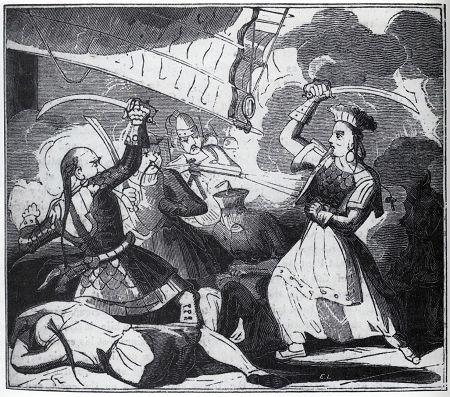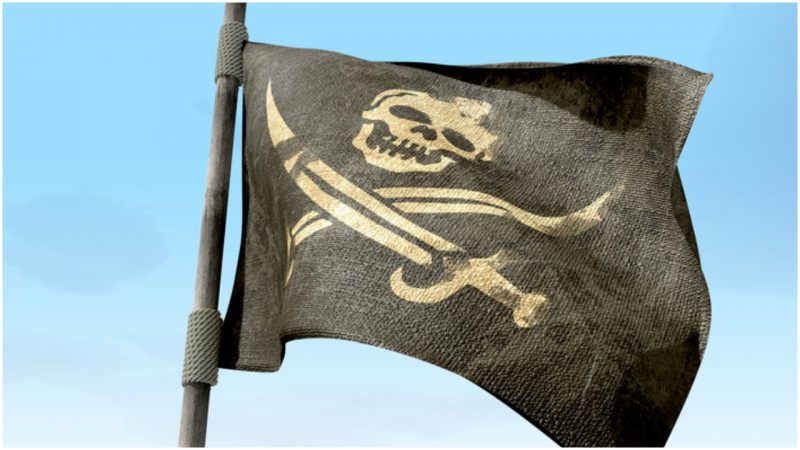“There comes a time in most men’s lives where they feel the need to raise the Black Flag.”
Royal sea captains such as Sir Francis Drake, Queen Elizabeth’s personal “Sea Dog,” raised the black flag to launch surprise attacks on the Spanish Armada. Aruj and Hizir Barbarossa, the read bearded ruthless corsairs of the Mediterranean, sailed under it upon their Sultan’s demand.
Captain Henry Morgan, Edward Teach aka Blackbeard, John Rackham (better known as Calico Jack), and Francois L’Ollonais, probably the cruelest buccaneer that ever set sail and troubled the waters of the Caribbean, all raised theirs because “land was created to provide a place for boats to visit.” Sailing under the black flag offered a greater chance to visit as much land as they liked, and of course, to raid, plunder, rape, and wreak havoc along the way.
Among all these state-sponsored privateers, marauders, corsairs, pillagers, and swashbuckling outlaws that roved the high seas, vicious men that are now romanticized as heroes in movies and literature, there is but one lady, a dame who once might have raised the black flag but instead raised a red one.
A Cantonese prostitute who walked away from the bed inside a floating brothel, she set foot on deck and turned out to be the greatest sea captain and perhaps the most ruthless pirate of them all. Madame Ching, the Terror of South China and commander of the notorious Red Flag Fleet, was recently brought to life in the popular franchise Pirates of the Caribbean, as Mistress Ching, one of the nine powerful lords to rule the “Seven Seas.”
Born 1775, in Guangzhou (Canton), it is as if she had no life nor history before she was captured by pirates and sold to a brothel ship on the deck in her hometown at the age of 15, where her name, Shin, is first mentioned alongside her job description as a prostitute.
Selling her self perhaps but sharp as a tack, she used her occupation and her skills to gain valuable pieces of information from her customers, some of them the elites of Southern China who let slip a secret or two during their “pillow talks.” Using these precious little secrets, the fille de joie moved up the ranks inside the brothel and set up a smuggling backdoor operation of her own on the outside.
By 1801, she owned the place and caught the eye of one of the most fearsome pirates, Cheng I, the grand commander of the Red Flag Fleet.
He had the ships and an already established pirate network, and she had invaluable information about some respected individuals. So their pillow talks soon turned into business talks and very soon led to a marriage for the infamous couple.

Side by side, the couple roved the seas with their powerful armada that steadily grew stronger and stronger. “Pirates consciously used violence and brutality to obtain money and goods, to seek vengeance against their enemies, and to instill fear in anyone who might resist them,” writes Robert J. Antony in his 2012 publication Bloodthirsty Pirates? Violence and Terror in the South China Sea in Early Modern Times. And although violence speaks louder than words in the books of many historians on this matter, it was words and perfectly played out extortion games against Ching Shin’s former wealthy and politically connected clients, as well as other mighty pirate captains, that gave them control over almost every single ship, and turned every previous enemy into a subordinate ally.
But before this even became a reality, Shin did what every shrewd businesswoman would do before pulling all the aces out of her sleeve and risking her savviness in vain. She struck a deal with her beloved soon-to-be-husband. A so-called premarital agreement that by the pirate code would grant her joint control over the whole fleet, an equal share of the loot, and a co-captain spot out on the deck.
With power and shrewdness now joined in wedlock, together they managed in no more than six years to form an alliance with almost every other large Cantonese pirate fleet and bring them under their command. In 1807, her husband died at the age of 42, lost at sea and was never to be found again, having been struck by a harsh tsunami in Vietnam. Vague news reached the ear of a grieving widow suggesting that parts of his ship appeared on the coast of a nearby island, but there weren’t any actual survivors left to tell the tale in more detail.
So what’s a savvy woman to do now? Captain or co-captain, she was still “only a woman” in the eyes of a “shark infested” sea of nasty pirates nonetheless, and every single one of them wanted to take her place.
Still, “where business acumen starts to display itself is in the way she became the overall head of the entire confederation,” writes Dian H. Murray, a professor of Chinese history at the Department of East Asian Languages and Culture as part of Stanford University, about what happened next, in her publication Pirates of the South China Coast, 1790 – 1810.
According to her, Ching, right after the death of her husband, surrounded by uncertainty and danger from all directions, used the unfavorable circumstances of Chang’s passing to her advantage and found a way to stay on top as commander, keeping any potential mutiny at bay. Not only that, but she managed to grow in strength, power, and command.
First, she remarried, choosing her husband’s adopted son, Cheung Po Tsai, who was just about to succeed his father, while all the while arranging meetings with every ally and powerful family member in order to strengthen the bond and present them what she had in mind for the future of the organization.
What she presented was the second thing on her list, a plan for unity through strictness and it seemed everyone was keen on it. Let us also not forget the fact that while her husband was dead, she was still the precious little secret keeper and the one with the influential people in her pocket. Within weeks, she had complete and absolute control over the whole Red Flag Fleet.
Combining all the ships and all the vessels of every other pirate captain, and gathering all the sailors and pirates that fell under their command, they still wouldn’t stand a chance against the mighty fleet of Cheng I Sao, as she came to be remembered. At this point in time, she captained more than 1,800 ships and had the manpower of more than 100, 000.
In order to rule unopposed, hold in check every single one of them, and keep the peace and unity within, Ching Shin, assisted by her new husband, devised and implemented strict rules of conduct that were severe even for pirates’ standards. For instance, in the spirit of loyalty and respect above everything else, every disobedience or act without a direct command resulted in death. On the spot. Stealing from the loot, off with the head. All captured goods and captives had to be counted and inspected or else.
Furthermore, rape was out of the question from that point forward, and anyone found doing it would be beheaded. In fact, many men were, until this past pirate tradition was eradicated. As for consensual sexual relationships with a female captive? Well, if it was done while on duty, it was off with the head for him then and there, and down the plank for the lady.
Aside from these, there were the more obvious ones like “no desertion was allowed,” that in time organized the crew to the extent that thousands of men were operating as one and earned her the name “the Terror of South China.” In pirate circles, she was a ruthless, fearless ruler, and to the outside world, for no less than three years, a real nuisance for England, France, Portugal, and the Qing Empire, which desired a pirate-less Chinese Sea for their commerce but simply could not get rid of her.
In those desperate times, the current Qing Emperor, Jiaqingdi, offered her a deal. Stop all pirate activities, dismantle your fleet, unmask the corruption chain, and walk free along with all the loot. It was 1810 and the situation within the organization was going from bad to worse anyway. The alliance was breaking, but no one from the outside knew that, so she negotiated a better one. A jail free card for her, her husband, and anyone she would name and wish to spare with all their “earnings” untouched at the expense of everyone else, who in all truthfulness probably wanted her dead anyway.
She and Cheung Po Tsai received full royal pardons, as well as all the others named on her list who escaped untouched, allowed to live their remaining years as free men. As for the others, well, as a win-win for both negotiating parties, her husband was assigned commander to a new pirate-hunting elite fleet of the Empire, given the task of hunting down whatever was left of the weakened and dissolved Red Flag Fleet.
So the poor prostitute with no name who grew to be the greatest sea captain of all time, commander of the largest pirate fleet and a real terror in South China, one who was wanted dead by all, escaped unpunished and alive. And not just alive but as royalty no less, as she went on to live her life for three full decades more, relaxing in relative peace and harmony, away from everything that brought her fame. She died in 1844, from an unknown cause, at the age of 69.
